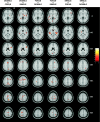Cerebellar involvement in response reassignment rather than attention
- PMID: 11784801
- PMCID: PMC6758676
- DOI: 10.1523/JNEUROSCI.22-02-00546.2002
Cerebellar involvement in response reassignment rather than attention
Abstract
A number of functional hypotheses have recently been advanced to account for how the cerebellum may contribute to cognition. Neuropsychological studies suggest the cerebellum is involved in switching attentional set. We present evidence that fails to support this hypothesis. Rather, we propose that in such tasks, the cerebellum is involved with the remapping of response alternatives to different types of stimuli. In our experiment, participants fixated on the center of a screen onto which a random presentation of four visual stimuli was presented. The stimuli were grouped along two dimensions (color: red square or blue square; shape: white circle or white triangle). Participants were instructed to respond with a button press only to presented stimuli for a particular dimension (e.g., red squares), to switch between two dimensions (where the target on the attended dimension served both as a signal for a response and as an indicator to shift attention to the other dimension), or to switch attention between two dimensions but make an overt response only to targets on one of the dimensions. Using functional imaging, we identify areas of lateral cerebellar cortex that are recruited when subjects must reassign motor responses to different stimuli. Furthermore, we demonstrate that switching of attention between dimensions without a motor response does not produce stronger activation within the cerebellum compared with conditions involving response and attention to a single dimension. These results suggest the cerebellum is involved in response reassignment.
Figures




Similar articles
-
4 T-fMRI study of nonspatial shifting of selective attention: cerebellar and parietal contributions.J Neurophysiol. 1998 Mar;79(3):1535-48. doi: 10.1152/jn.1998.79.3.1535. J Neurophysiol. 1998. PMID: 9497430
-
What visual information do children and adults consider while switching between tasks? Eye-tracking investigation of cognitive flexibility development.Dev Psychol. 2010 Jul;46(4):955-72. doi: 10.1037/a0019674. Dev Psychol. 2010. PMID: 20604615
-
MEG reveals different contributions of somatomotor cortex and cerebellum to simple reaction time after temporally structured cues.Hum Brain Mapp. 2006 Jul;27(7):552-61. doi: 10.1002/hbm.20200. Hum Brain Mapp. 2006. PMID: 16247784 Free PMC article.
-
Universal Transform or Multiple Functionality? Understanding the Contribution of the Human Cerebellum across Task Domains.Neuron. 2019 Jun 5;102(5):918-928. doi: 10.1016/j.neuron.2019.04.021. Neuron. 2019. PMID: 31170400 Free PMC article. Review.
-
A review of differences between basal ganglia and cerebellar control of movements as revealed by functional imaging studies.Brain. 1998 Aug;121 ( Pt 8):1437-49. doi: 10.1093/brain/121.8.1437. Brain. 1998. PMID: 9712006 Review.
Cited by
-
Comparison of anaesthetic- and seizure-induced states of unconsciousness: a narrative review.Br J Anaesth. 2021 Jan;126(1):219-229. doi: 10.1016/j.bja.2020.07.056. Epub 2020 Sep 18. Br J Anaesth. 2021. PMID: 32951841 Free PMC article. Review.
-
Learning of sensory sequences in cerebellar patients.Learn Mem. 2004 May-Jun;11(3):347-55. doi: 10.1101/lm.66904. Learn Mem. 2004. PMID: 15169865 Free PMC article. Clinical Trial.
-
Evaluating the influence of motor control on selective attention through a stochastic model: the paradigm of motor control dysfunction in cerebellar patient.Biomed Res Int. 2014;2014:162423. doi: 10.1155/2014/162423. Epub 2014 Feb 9. Biomed Res Int. 2014. PMID: 24672782 Free PMC article.
-
Structural cerebellar correlates of cognitive and motor dysfunctions in cerebellar degeneration.Brain. 2017 Mar 1;140(3):707-720. doi: 10.1093/brain/aww327. Brain. 2017. PMID: 28043955 Free PMC article.
-
A 7T fMRI study of cerebellar activation in sequential finger movement tasks.Exp Brain Res. 2013 Jul;228(2):243-54. doi: 10.1007/s00221-013-3558-5. Epub 2013 Jun 4. Exp Brain Res. 2013. PMID: 23732948 Clinical Trial.
References
-
- Akshoomoff NA, Courchesne E. A new role for the cerebellum in cognitive operations. Behav Neurosci. 1992;106:731–738. - PubMed
-
- Albus JS. The theory of cerebellar function. Mathematical Biosciences. 1971;10:25–61.
-
- Allen G, Buxton RB, Wong EC, Courchesne E. Attentional activation of the cerebellum independent of motor involvement. Science. 1997;275:1940–1943. - PubMed
-
- Berman KF, Ostrem JL, Randolph C, Gold J, Goldberg TE, Coppola R, Carson RE, Herscovitch P, Weinberger DR. Physiological activation of a cortical network during performance of the Wisconsin Card Sorting Test: a positron emission tomography study. Neuropsychologia. 1995;33:1027–1046. - PubMed
Publication types
MeSH terms
Grants and funding
LinkOut - more resources
Full Text Sources
Medical
